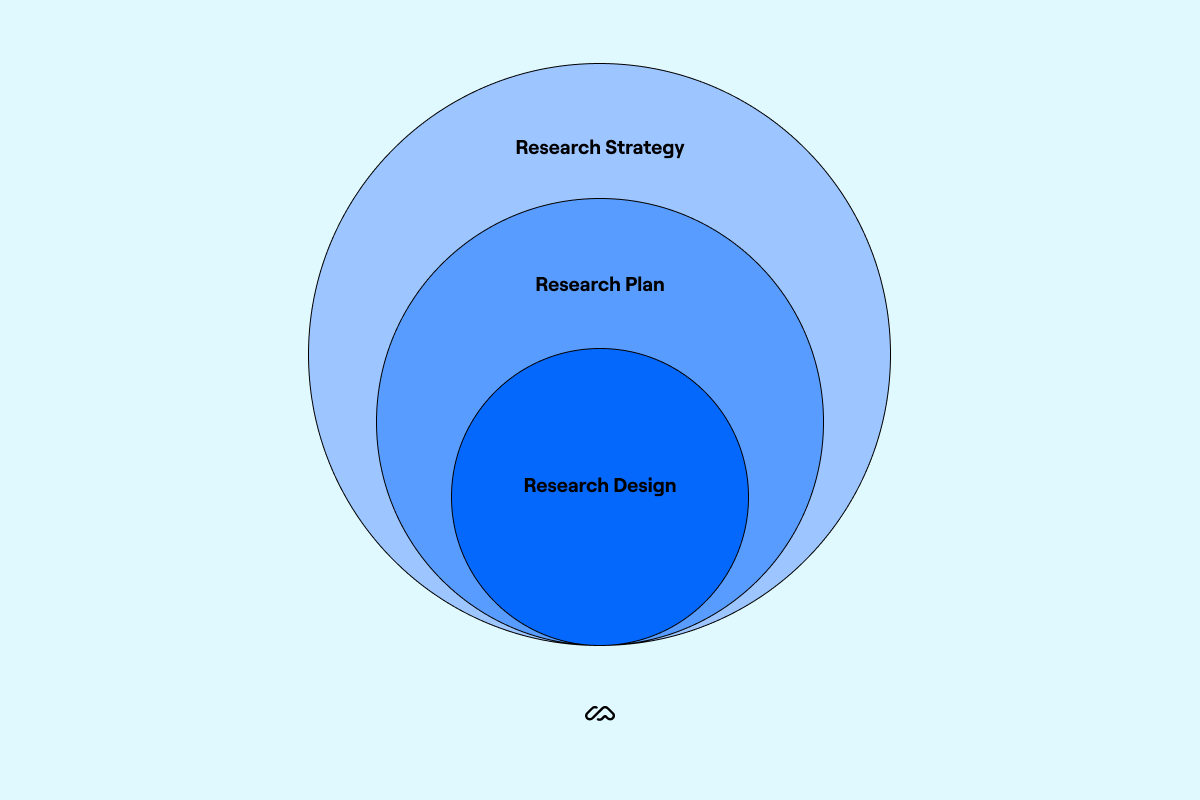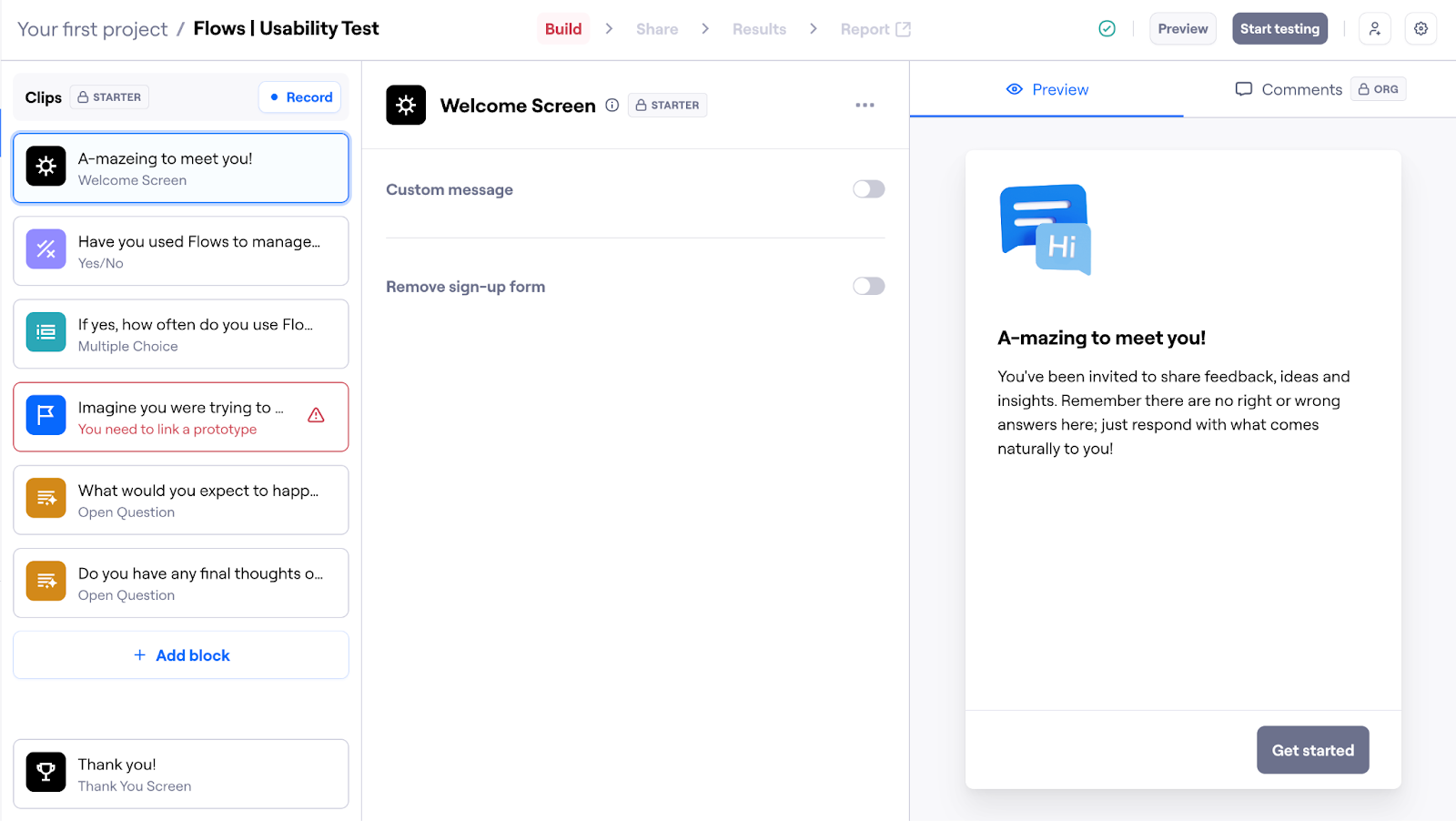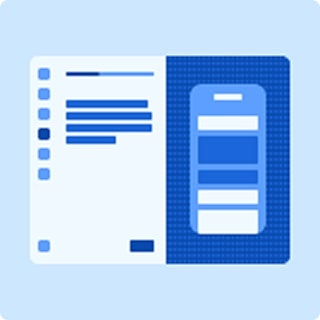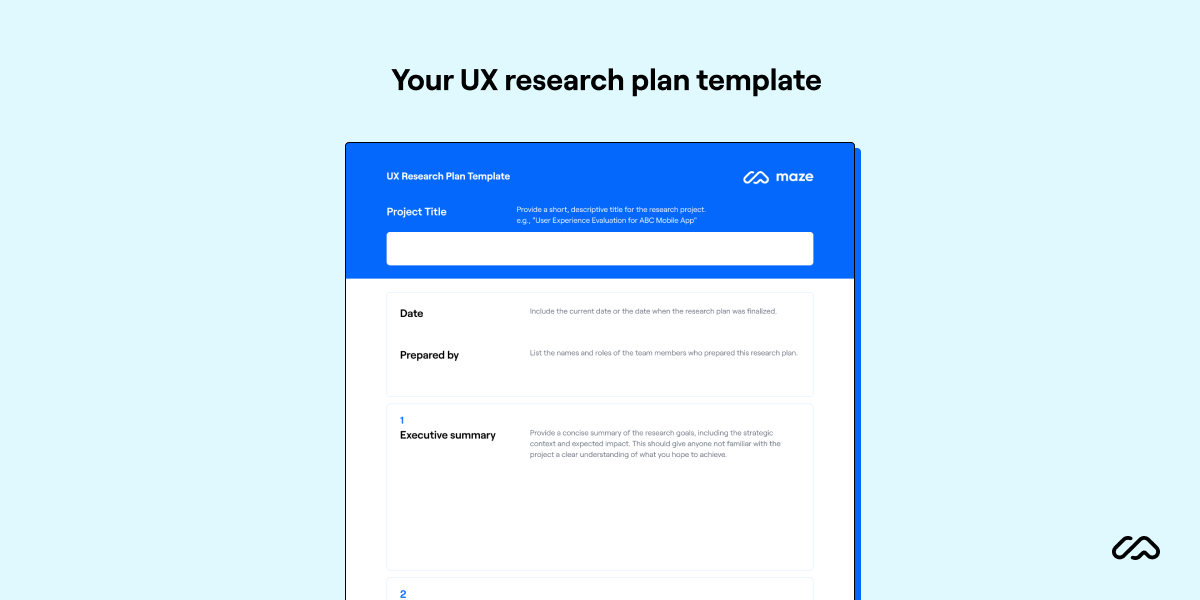Chapter 3
Essential elements of an effective UX research plan (examples + templates)
Conducting UX research without a plan is like moving to another country without knowing the language—confusing and exhausting.
To avoid wasting time and resources, it’s crucial to set achievable research goals and work on developing a research plan that’s clear, comprehensive, and aligned with your overarching business goals and research strategy.
A good UX research plan sets out the parameters for your research, and guides how you’ll gather insights to inform product development. In this chapter, we share a step-by-step guide to creating a research plan, including templates and tactics for you to try. You’ll also find expert tips from Paige Bennett, Senior User Research Manager at Affirm, and Sinéad Davis Cochrane, Research Manager at Workday.

What is a UX research plan?
A UX research plan—not to be confused with a UX research strategy or research design—is a plan to guide individual user experience (UX) research projects.
It's a living document that includes a detailed explanation of tactics, methods, timeline, scope, and task owners. It should be co-created and shared with key stakeholders, so everyone is familiar with the project plan, and product teams can meet strategic goals.
A UX research plan is different to a research strategy and research design in both its purpose and contents. Let’s take a look.
Research plan vs. research design vs. research strategy: What’s the difference?
While your UX research plan should be based on strategy, it’s not the same thing. Your UX strategy is a high-level document that contains goals, budget, vision, and expectations. Meanwhile, a plan is a detailed document explaining how the team will achieve those strategic goals. Research design is the form your research itself takes.

In short, a strategy is a guide, a plan is what drives action, and design is the action itself.
Research design | A specific part of your research plan, focusing on exact steps and techniques to carry out research. |
|
|---|---|---|
Research plan | A broad outline of the entire research project—this should set out the what and why of your project. |
|
Research strategy | A guiding plan for everything related to UX research, from vision to budget. |
|
What are the benefits of using a UX research plan?
Conducting research without goals and parameters is aimless. A UX research plan is beneficial for your product, user, and business—by building a plan for conducting UX research, you can:
- Streamline processes and add structure
- Work toward specific, measurable goals
- Align and engage stakeholders
- Save time by avoiding rework
Streamline processes and add structure
The structure of a research plan allows you to set timelines, expectations, and task owners, so everyone on your team is aligned and empowered to make decisions. Since there’s no second guessing what to do next or which methods to use, you’ll find your process becomes simpler and more efficient. It’s also worth standardizing your process to turn your plan into a template that you can reuse for future projects.
Work toward specific, measurable goals
When you set research goals based on strategy, you’ll find it easier to track your team’s progress and keep the project in scope, on time, and on budget. With a solid, strategy-based UX research plan you can also track metrics at different stages of the project and adjust future tactics to get better research findings.
Align and engage stakeholders
“It’s important to make sure your stakeholders are on the same page with regards to scope, timeline, and goals before you start," explains Paige Bennett, Senior User Research Manager at Affirm. That's because, when stakeholders are aligned, they're much more likely to sign off on product changes that result from UX research.
A written plan is a collaborative way to involve stakeholders in your research and turn them into active participants rather than passive observers. As they get involved, they'll make useful contributions and get a better understanding of your goals.
Save time by avoiding rework
A UX research plan helps you save time and money quite simply because it’s easier and less expensive to make design or prototype changes than it is to fix usability issues once the product is coded or fully launched. Additionally, having a plan gives your team direction, which means they won’t be conducting research and talking to users without motive, and you’ll be making better use of your resources. What’s more, when everyone is aligned on goals, they’re empowered to make informed decisions instead of waiting for their managers’ approval.
What should a UX research plan include?
In French cuisine, the concept of mise en place—putting in place—allows chefs to plan and set up their workspace with all the required ingredients before cooking. Think of your research plan like this—laying out the key steps you need to go through during research, to help you run a successful and more efficient study.
Here’s what you should include in a UX research plan:
- A brief reminder of the strategy and goals
- An outline of the research objectives
- The purpose of the plan and studies
- A short description of the target audience, sample size, scope, and demographics
- A detailed list of expectations including deliverables, timings, and type of results
- An overview of the test methods and a short explanation of why you chose them
- The test set up or guidelines to outline everything that needs to happen before the study: scenarios, screening questions, and duration of pilot tests
- Your test scripts, questions to ask, or samples to follow
- When and how you’ll present the results
- Cost estimations or requests to go over budget
How to create a UX research plan
Now we’ve talked through why you need a research plan, let’s get into the how. Here’s a short step-by-step guide on how to write a research plan that will drive results.
- Define the problem statement
- Get stakeholders’ buy-in
- Identify your objectives
- Choose the right research method
- Recruit participants
- Prepare the brief
- Establish the timeline
- Decide how you’ll present your findings
1. Define the problem statement
One of the most important purposes of a research plan is to identify what you’re trying to achieve with the research, and clarify the problem statement. For Paige Bennett, Senior User Research Manager at Affirm, this process begins by sitting together with stakeholders and looking at the problem space.
“We do an exercise called FOG, which stands for ‘Fact, Observation, Guess’, to identify large gaps in knowledge,” says Paige. “Evaluating what you know illuminates questions you still have, which then serves as the foundation of the UX research project.”
You can use different techniques to identify the problem statement, such as stakeholder interviews, team sessions, or analysis of customer feedback. The problem statement should explain what the project is about—helping to define the research scope with clear deliverables and objectives.
2. Identify your objectives
Research objectives need to align with the UX strategy and broader business goals, but you also need to define specific targets to achieve within the research itself—whether that’s understanding a specific problem, or measuring usability metrics. So, before you get into a room with your users and customers, “Think about the research objectives: what you’re doing, why you’re doing it, and what you expect from the UX research process,” explains Sinéad Davis Cochrane, Research Manager at Workday.
Examples of research objectives might be:
- Learn at what times users interact with your product
- Understand why users return (or not) to your website/app
- Discover what competitor products your users are using
- Uncover any pain points or challenges users find when navigating with your product
- Gauge user interest in and prioritize potential new features
A valuable purpose of setting objectives is ensuring your project doesn't suffer from scope creep. This can happen when stakeholders see your research as an opportunity to ask any question. As a researcher, Sinéad believes your objectives can guide the type of research questions you ask and give your research more focus. Otherwise, anything and everything becomes a research question—which will confuse your findings and be overwhelming to manage.
Sinéad shares a list of questions you should ask yourself and the research team to help set objectives:
- What are you going to do with this information?
- What decisions is it going to inform?
- How are you going to leverage these insights?
Another useful exercise to help identify research objectives is by asking questions that help you get to the core of a problem. Ask these types of questions before starting the planning process:
- Who are the users you’re designing this for?
- What problems and needs do they have?
- What are the pain points of using the product?
- Why are they not using a product like yours?
3. Get stakeholders buy-in
It’s good practice to involve stakeholders at early stages of plan creation to get everyone on board. Sharing your UX research plan with relevant stakeholders means you can gather context, adjust based on comments, and gauge what’s truly important to them. When you present the research plan to key stakeholders, remember to align on the scope of research, and how and when you’ll get back to them with results.
Stakeholders usually have a unique vision of the product, and it’s crucial that you’re able to capture it early on—this doesn’t mean saying yes to everything, but listening to their ideas and having a conversation. Seeing the UX research plan as a living document makes it much easier to edit based on team comments. Plus, the more you listen to other ideas, the easier it will be to evangelize research and get stakeholder buy-in by helping them see the value behind it.
I expect my stakeholders to be participants, and I outline how I expect that to happen. That includes observing interviews, participating in synthesis exercises, or co-presenting research recommendations.

Paige Bennett
Senior User Research Manager at Affirm
4. Choose the right research method

Choose between the different UX research methods to capture different insights from users.
To define the research methods you’ll use, circle back to your research objectives, what stage of the product development process you’re in, and the constraints, resources, and timeline of the project. It’s good research practice to use a mix of different methods to get a more complete perspective of users’ struggles.
For example, if you’re at the start of the design process, a generative research method such as user interviews or field studies will help you generate new insights about the target audience. Or, if you need to evaluate how a new design performs with users, you can run usability tests to get actionable feedback.
It’s also good practice to mix methods that drive quantitative and qualitative results so you can understand context, and catch the user sentiment behind a metric. For instance, if during a remote usability test, you hear a user go ‘Ugh! Where’s the sign up button?’ you’ll get a broader perspective than if you were just reviewing the number of clicks on the same test task.
Examples of UX research methods to consider include:
- Five-second testing
- User interviews
- Surveys
- Field studies
- Card sorting
- Tree testing
- Focus groups
- Usability testing
- Diary studies
- Live website testing
Tip ✨
Check out our top UX research templates. Use them as a shortcut to get started on your research.
5. Determine how to recruit participants
Every research plan should include information about the participants you need for your study, and how you’ll recruit them. To identify your perfect candidate, revisit your goals and the questions that need answering, then build a target user persona including key demographics and use cases. Consider the resources you have available already, by asking yourself:
- Do you have a user base you can tap into to collect customer insights?
- Do you need to hire external participants?
- What’s your budget to recruit users?
- How many users do you need to interact with?
When selecting participants, make sure they represent all your target personas. If different types of people will be using a certain product, you need to make sure that the people you research represent these personas. This means not just being inclusive in your recruitment, but considering secondary personas—the people who may not be your target user base, but interact with your product incidentally.
You should also consider recruiting research participants to test the product on different devices. Paige explains: “If prior research has shown that behavior differs greatly between those who use a product on their phone versus their tablet, I need to better understand those differences—so I’m going to make sure my participants include people who have used a product on both devices.”
During this step, make sure to include information about the required number of participants, how you’ll get them to participate, and how much time you need per user. The main ways to recruit testers are:
- Using an online participant recruitment tool like Maze Panel
- Putting out physical or digital adverts in spaces that are relevant to your product and user
- Reaching out to existing users
- Using participants from previous research
- Recruiting directly from your website or app with a tool like In-Product Prompts
5.1. Determine how you’ll pay them
You should always reward your test participants for their time and insights. Not only because it’s the right thing to do, but also because if they have an incentive they’re more likely to give you complete and insightful answers. If you’re hosting the studies in person, you’ll also need to cover your participants' travel expenses and secure a research space. Running remote moderated or unmoderated research is often considered to be less expensive and faster to complete.
Pro tip ✨
If you’re testing an international audience, remember to check your proposed payment system works worldwide—this might be an Amazon gift card or prepaid Visa cards.
6. Prepare the brief
The next component of a research plan is to create a brief or guide for your research sessions. The kind of brief you need will vary depending on your research method, but for moderated methods like user interviews, field studies, or focus groups, you’ll need a detailed guide and script. The brief is there to remind you which questions to ask and keep the sessions on track.
Your script should cover:
- Introduction: A short message you’ll say to participants before the session begins. This works as a starting point for conversations and helps set the tone for the meeting. If you’re testing without a moderator, you should also include an introductory message to explain what the research is about and the type of answers they should give (in terms of length and specificity).
- Interview questions: Include your list of questions you’ll ask participants during the sessions. These could be examples to help guide the interviews, specific pre-planned questions, or test tasks you’ll ask participants to perform during unmoderated sessions.
- Outro message: Outline what you'll say at the end of the session, including the next steps, asking participants if they are open to future research, and thanking them for their time. This can be a form you share at the end of asynchronous sessions.
It’s crucial you remember to ask participants for their consent. You should do this at the beginning of the test by asking if they’re okay with you recording the session. Use this space to lay out any compensation agreements as well. Then, ask again at the end of the session if they agree with you keeping the results and using the data for research purposes. If possible, explain exactly what you’ll do with their data. Double check and get your legal team’s sign-off on these forms.
7. Establish the timeline
Next in your plan, estimate how long the research project will take and when you should expect to review the findings. Even if not exact, determining an approximate timeline (e.g., two-three weeks) will enable you to manage stakeholders’ expectations of the process and results.
Many people believe UX research is a lengthy process, so they skip it. When you set up a timeline and get stakeholders aligned with it, you can debunk assumptions and put stakeholders’ minds at ease. Plus, if you’re using a product discovery tool like Maze, you can get answers to your tests within days.
8. Decide how you’ll present your findings
When it comes to sharing your findings with your team, presentation matters. You need to make a clear presentation and demonstrate how user insights will influence design and development. If you’ve conducted UX research in the past, share data that proves how implementing user insights has improved product adoption.
Examples of ways you can present your results include:
- A physical or digital PDF report with key statistics and takeaways
- An interactive online report of the individual research questions and their results
- A presentation explaining the results and your findings
- A digital whiteboard, like Miro, to display the results
In your plan, mention how you’ll share insights with the product team. For example, if you’re using Maze, you can start by emailing everyone the ready-to-share report and setting up a meeting with the team to identify how to bring those insights to life. This is key, because your research should be the guiding light for new products or updates, if you want to keep development user-centric. Taking care over how you present your findings will impact whether they’re taken seriously and implemented by other stakeholders.
Your UX research plan template: Free template + example
Whether you’re creating the plan yourself or delegating to your team, a clear UX research plan template cuts your prep time in half.
Find our customizable free UX research plan template here, and keep reading for a filled-in example.
Example: Improving user adoption of a project management tool called Flows
Now, let’s go through how to fill out this template and create a UX research plan with an example.
Executive summary:
Flows aims to increase user adoption and tool engagement by 30% within the next 12 months. Our B2B project management software has been on the market for 3 years and has 25,000 active users across various industries.
By researching the current product experience with existing users, we’ll learn what works and what doesn’t in order to make adjustments to the product and experience.
Research objectives:
Purpose of the plan and studies:
The purpose is to gather actionable insights into user needs, behaviors, and challenges to inform updates that will drive increased adoption and engagement of 30% for the B2B project management tool within 12 months.
Target audience, sample size, scope, and demographics:
Expectations, deliverables, timings, and type of results:
Research methodologies:
*Some teams will take part in more than one research session.
Research analysis methods:
We are doing a mixed methods study.
User interviews are our primary method for gathering qualitative data, and will be analyzed using thematic analysis.
- Quantitative data will be pulled from usability tests to evaluate the effectiveness of our current design.
- Research set up and guidelines:
- Create baselines surveys to gauge current usage and pain points
- Develop interview/discussion guides and usability testing scenarios
- Pilot test materials with two teams
- User interviews: 60 mins, semi-structured; usability tests: 90 mins
- Findings will be presented in a research report for all stakeholders
Research scripts, questions, and samples:
User interview questions:
- What’s your experience with Flows?
- How does Flows fit into your workflow?
- What is your understanding of Flows’ features?
- What do you wish Flows could do that it currently doesn’t?
Usability test sample with Maze:

Cost estimations or budget requests/pricing:
Total estimated budget: $8,000
More free customizable templates for UX research
Whether you’re creating the plan yourself or are delegating this responsibility to your team, here are six research templates to get started:
- UX research plan template: This editable Miro research project plan example helps you brainstorm user and business-facing problems, objectives, and questions
- UX research brief: You need a clear brief before you conduct UX research—Milanote shares a template that will help you simplify the writing process
- User testing synthesis: Trello put together a sample board to organize user testing notes—you can use this as a guide, but change the titles to fit your UX research purposes
- Usability testing templates: At Maze, we’ve created multiple templates for conducting specific UX research methods—this list will help you create different remote usability tests
- Information architecture (IA) tests template: The way you organize the information in your website or app can improve or damage the user experience—use this template to run IA tests easily
- Feedback survey templates: Ask users anything through a survey, and use these templates to get creative and simplify creation
Everything you need to know about UX research plans
We all know that a robust plan is essential for conducting successful UX research. But, in case you want a quick refresher on what we’ve covered:
- Using a UX research strategy as a starting point will make your plan more likely to succeed
- Determine your research objectives before anything else
- Use a mix of qualitative and quantitative research methods
- Come up with clear personas so you can recruit and test a group of individuals that’s representative of your real end users
- Involve stakeholders from the beginning to get buy-in
- Be vocal about timelines, budget, and expected research findings
- Use the insights to power your product decisions and wow your users; building the solution they genuinely want and need
UX research can happen at any stage of the development lifecycle. When you build products with and for users, you need to include them continuously at various stages of the process.
It’s helpful to explore the need for continuous discovery in your UX research plan and look for a tool like Maze that simplifies the process for you. We’ll cover more about the different research methods and UX research tools in the upcoming chapters—ready to go?
Frequently asked questions
What’s the difference between a UX research plan and a UX research strategy?
What’s the difference between a UX research plan and a UX research strategy?
The difference between a UX research plan and a UX research strategy is that they cover different levels of scope and detail. A UX research plan is a document that guides individual user experience (UX) research projects. UX research plans are shared documents that everyone on the product team can and should be familiar with. A UX research strategy, on the other hand, outlines the high-level goals, expectations, and demographics of the organization’s approach to research.
What should you include in a user research plan?
What should you include in a user research plan?
Here’s what to include in a user research plan:
- Problem statement
- Research objectives
- Research methods
- Participants' demographics
- Recruitment plan
- User research brief
- Expected timeline
- How to present findings
How do you write a research plan for UX design?
How do you write a research plan for UX design?
Creating a research plan for user experience (UX) requires a clear problem statement and objectives, choosing the right research method, recruiting participants and briefing them, and establishing a timeline for your project. You'll also need to plan how you'll analyze and present your findings.
How do you plan a UX research roadmap?
How do you plan a UX research roadmap?
To plan a UX research roadmap, start by identifying key business goals and user needs. Align research activities with product milestones to ensure timely insights. Prioritize research methods—like surveys, interviews, and usability tests—based on the project phase and objectives. Set clear timelines and allocate resources accordingly. Regularly update stakeholders on progress and integrate feedback to refine the roadmap continuously.





